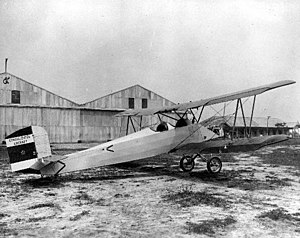Dayton-Wright TW-3
| PT-1 | |
|---|---|
 |
|
| Consolidated PT-1 | |
| Role | Primary Trainer |
| Manufacturer | Consolidated |
| Designer | Colonel Virginius E. Clark |
| Introduction | 1921 |
| Primary users |
United States Army Air Service United States Navy Siam U.S. Army National Guard |
| Produced | 1923 |
| Number built | 221 |
| Unit cost |
$8,000
|
| Developed into | Consolidated PT-3 |
The Consolidated PT-1 Trusty (company designation Model 1) was a biplane primary trainer used by the United States Army Air Service.
In 1921, Colonel Virginius Clark, chief designer of the Dayton-Wright Company, designed the Chummy sporting biplane. The airframe was advanced in its use of the new Clark Y airfoil thick-section aerofoil and a welded fuselage framework of chrome-molybdenum steel tubing. A departure from the all-wood structures found in other trainers, the structure proved sturdy and dependable. It was offered to the US Army Air Service as a replacement for the Curtiss JN-4D trainer, with a choice of Le Rhone or Clerget rotary piston engines.
In 1922, the Army ordered three TA-3 (Trainer, Air-cooled, Type 3) machines for evaluation with the Le Rhone engine and dual controls. Evaluation showed that the type had the makings of a good trainer, but was somewhat lacking in power, so in 1923 Dayton-Wright re-engined one TA-3 with a more powerful 110 hp (82 kW) Le Rhone.
The USAAS then ordered ten examples of this up-engined model, and these were the last US Army aircraft to be delivered with a rotary-engine. Appreciating this type of powerplant had passed its development peak, the USAAS then contracted for three examples of the TW-3 (Trainer, Water-cooled, Type 3) with a 150 hp (112 kW) Wright-Hispano I V8. The revised type clearly had greater long-term potential, and in June 1923 the USAAS contracted for 20 TW-3 production aircraft, together with enough spare parts for the construction of another three aircraft. At this time the General Motors Corporation was thinking of pulling out of the aircraft business and closing its Dayton-Wright subsidiary, so Reuben Fleet of the Gallaudet company secured rights to the Dayton-Wright trainer design. When Gallaudet shareholders expressed disapproval at this move, Fleet left the company and established the Consolidated Aircraft Corporation.
...
Wikipedia
